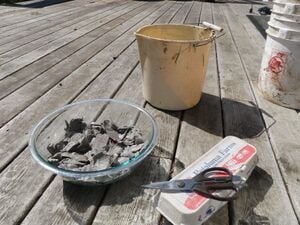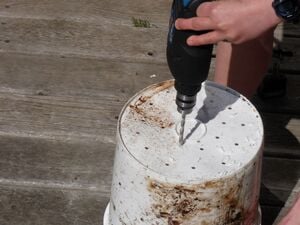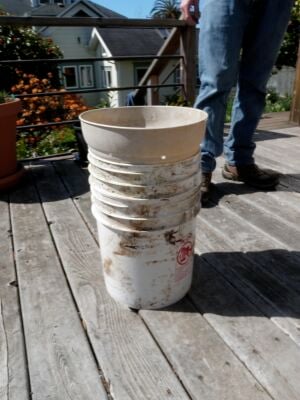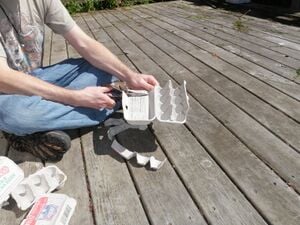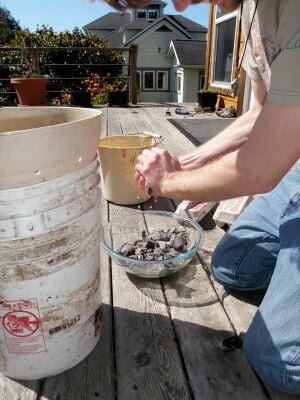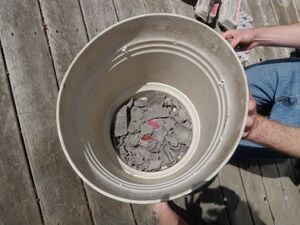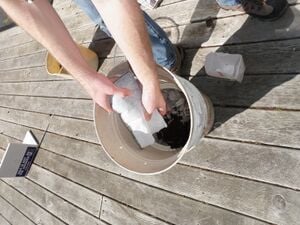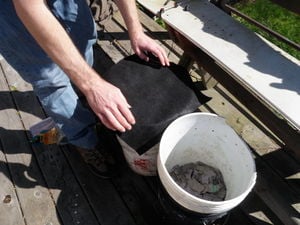
Three opaque buckets are "nested" inside of each other. 1/4 inch holes are drilled in the bottom and around the lip of the top two for ventilation and to allow the worms to migrate when you swap active buckets. A layer of moistened bedding is placed in the bottom of the top bucket, and on top of that, the worms (about 1/2 pound or 150 ct. for a five-gallon sized system; don't spread them out, they'll do it naturally) with a little starter soil or compost (if you get your worms from a garden shop, they will come in suitable organic matter). Another layer of bedding placed loosely over the worms to keep them cool and moist. A lid fixed tightly over the top bucket keeps pests out. After the worms acclimate, you may begin feeding them. The castings will commingle with the bedding and fall through the holes, and the tea will collect in the bottom bucket. Eventually your worms may reproduce. Information on what to look for and expect can be found at the Vermiculture page.
Building Instructions[edit | edit source]
How to construct your own vermicomposting bin from 5-gallon, 4-gallon, or any size buckets (worm occupancy varies with size). As taught at the Jefferson School Teach-In.
Materials[edit | edit source]
- 3 nesting buckets
- 1 lid (can be improvised)
- Drill and 1/4 inch bit or smaller
- Bedding: the bedding can be any organic material such as newspaper, cardboard, straw, or egg cartons
- Scissors to cut the bedding (optional, you can also shred with your hands)
- Bucket or bowl of water
- 1/2 pound red worms
- food scraps
How to Build[edit | edit source]
Place a thin layer of bedding in the base of your top bucket. This will lay over the holes that you drilled in step 2. The bedding will be home for your worms. Fluff the bedding as you add it- do not pack it in tight. Your worms will need some space to crawl around!
Place the lid loosely on the top bucket. In this example, we used landscaping cloth affixed with a rubber band, but this made access difficult. If you use an improvised lid such as this, we'd recommend using 8 clothespins or paper-clamps, but the lid that came with the bucket is the preferred solution. Also, be mindful you do not cover up the ventilation holes under the lip of your top bucket.
Costs[edit | edit source]
The table below outlines the costs involved to making the system previously described.
| Quantity | Material | Source | Cost ($) | Total ($) |
|---|---|---|---|---|
| 3 | 5 gallon bucket | Any hardware shop | 2.50 | 7.50 |
| 1 | pounds shredded bedding material | scraps | 0 | 0 |
| 1 | box of red worms (usually 1 lb.-enough for two systems) | Most gardening stores (In Humboldt County: Mad River Gardens) | 15 | 15 |
| 1 | handful food waste | "waste" | 0 | 0 |
| Total Cost | $22.50 | |||
Maintainence[edit | edit source]
Some general guidelines regarding what can be feed to the worms is as follows:
| YES | NO |
|---|---|
| Fruit and vegetable scraps | Meat Products |
| Paper and cardboard | Dairy Products |
| Egg shelled (crushed) | Bones |
| Yard clippings (in moderation) | Fats, oils and grease |
| Coffee grounds and tea bags | Onions |
| Animal hair | Garlic |
| Grain products | Citrus |
- Store your system in a dark area, ideally between 65-80 degrees Fahrenheit.
- Keep the bedding moist. Often times, scraps can introduce enough moisture into the system, but if worms start dying it might be because they are drying out. Bedding should be damp to the touch, but not soaked. Use a watering can or sprinkle water on the bedding if it needs more moisture.
- Start slowly when you begin adding food scraps. One handful of food scraps during the first week is enough. Later, you can add one handful three to four times a week. If you notice worms dying as you feed them more, they are probably overheating, and you should reduce the amount of food back to the previous level.
- If your bin begins to smell putrid, the system is likely becoming anaerobic (not enough oxygen throughout the organic material to facilitate decomposition). The material will appear sodden if this is happening, and it can be fixed by adding dry bedding and/or eliminating really moist scraps from your input.
- Your worms will migrate towards the food. When you want to use your compost, simply switch the top bucket with the middle one. In the old middle (new top) bucket place fresh bedding and some of the old compost to get the worms started. Once you start placing scraps in the new top bucket, the worms will move upstairs. Once they are moved, take the middle bucket and change the bedding separating out the castings from the remaining bedding. The compost tea should have made it's way to the bottom bucket. Dilute this with water using a 20:1 ratio and apply directly to plants with a spray bottle. The castings can be mixed directly into soil when you plant or sprinkled around plant base mid-season.[1]
